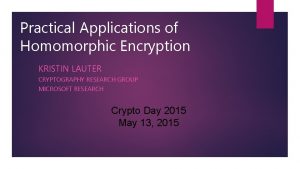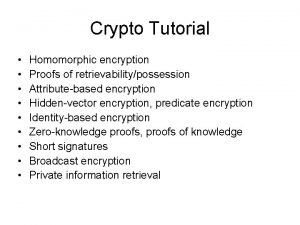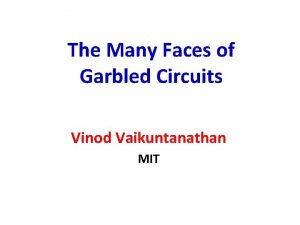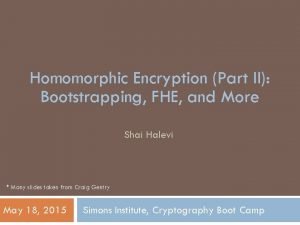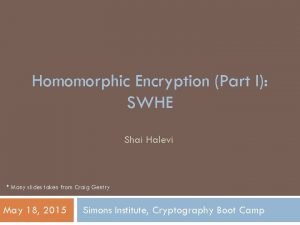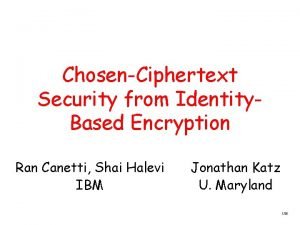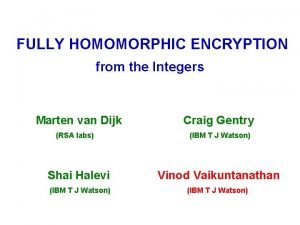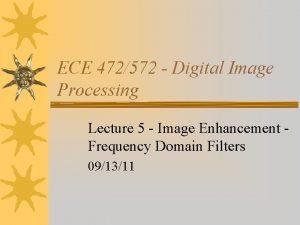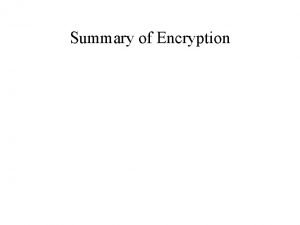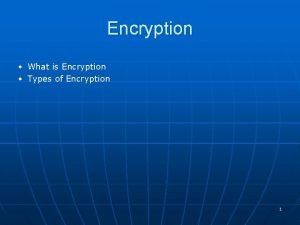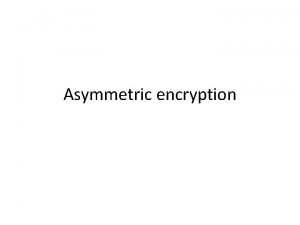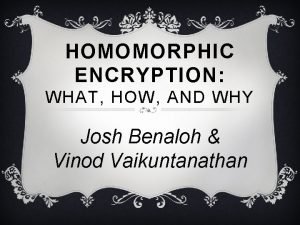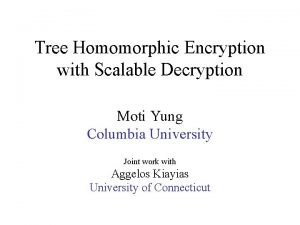Homomorphic Encryption Mike Merry Motivations for homomorphic encryption











![A formal definition [1] • [1] Armknecht, F. , Boyd, C. , Carr, C. A formal definition [1] • [1] Armknecht, F. , Boyd, C. , Carr, C.](https://slidetodoc.com/presentation_image/a951b25bd8324882eeff0acfcb7c2822/image-12.jpg)




![Bootstrapping [2] • [2] Gentry, C. (2009). Fully homomorphic encryption using ideal lattices. In Bootstrapping [2] • [2] Gentry, C. (2009). Fully homomorphic encryption using ideal lattices. In](https://slidetodoc.com/presentation_image/a951b25bd8324882eeff0acfcb7c2822/image-17.jpg)







![Dijk and Gentry’s FHE over the integers [3] • [3] Van Dijk, M. , Dijk and Gentry’s FHE over the integers [3] • [3] Van Dijk, M. ,](https://slidetodoc.com/presentation_image/a951b25bd8324882eeff0acfcb7c2822/image-25.jpg)



- Slides: 28

Homomorphic Encryption Mike Merry

• Motivations for homomorphic encryption • What do we need? • What is homomorphic encryption? • How do we make it work? • An example of how to do it

• Motivations for homomorphic encryption • What is necessary? • What is homomorphic encryption? • How do we make it work? • An example of how to do it

Motivations • Medical data is sensitive • Would like to use machinelearning to process it • Do you trust putting it in the cloud? • Do you trust the integrity of these servers all the time, in all jurisdictions? • Would still like to use cloud services on the data Medical data

e’ e Enc(k, m = e) Dec(k, e) = m m f(m) m’

g(e) e’ e Enc(k, m = e) Dec(k, e) = m m f(m) m’

g(e) e’ e Enc(k, m = e) Dec(k, e) = m m f(m) m’

• Motivations for homomorphic encryption • What do we need? • What is homomorphic encryption? • How do we make it work? • An example of how to do it

What do we need? • Process data: • • In any way we want On an insecure environment Without leaking information about the data In a time- and space-efficient manner • We are not (necessarily) concerned with hiding what we are doing • This is called Functional Encryption (FE) and is related, but distinct

• Motivations for homomorphic encryption • What do we need? • What is homomorphic encryption? • How do we make it work? • An example of how to do it

A (reasonably loose) definition • Let U be unencrypted space, and be E encrypted space. Let f: U → U be a function that we want to compute on our data • We would like to find g: E → E such that g(e) = Enc(k, f(m)), that is efficient and secure
![A formal definition 1 1 Armknecht F Boyd C Carr C A formal definition [1] • [1] Armknecht, F. , Boyd, C. , Carr, C.](https://slidetodoc.com/presentation_image/a951b25bd8324882eeff0acfcb7c2822/image-12.jpg)
A formal definition [1] • [1] Armknecht, F. , Boyd, C. , Carr, C. , Gjosteen, K. , Jaschke, A. , Reuter, C. A. , & Strand, M. (2015). A Guide to Fully Homomorphic Encryption. Cryptology e. Print Archive, 1– 35. Retrieved from https: //eprint. iacr. org/2015/1192

Properties: correctness •

Properties: Compactness •

Properties: Privacy • Circuit privacy: The distribution of the evaluation of a circuit in homomorphic space is indistinguishable from the encryption of the output of the circuit • A different way of viewing Circuit Privacy is to consider whether you would be happy to release the encrypted results of a message-space function. If you would, then as the distribution of the evaluation space is the same, you should be happy to release those results as well. • This doesn’t mean the distributions are equivalent to fresh cipher texts as the distribution of f(x) is not random.

• Motivations for homomorphic encryption • What do we need? • What is homomorphic encryption? • How do we make it work? • An example of how to do it
![Bootstrapping 2 2 Gentry C 2009 Fully homomorphic encryption using ideal lattices In Bootstrapping [2] • [2] Gentry, C. (2009). Fully homomorphic encryption using ideal lattices. In](https://slidetodoc.com/presentation_image/a951b25bd8324882eeff0acfcb7c2822/image-17.jpg)
Bootstrapping [2] • [2] Gentry, C. (2009). Fully homomorphic encryption using ideal lattices. In Proceedings of the 41 st annual ACM symposium on Symposium on theory of computing - STOC ’ 09 (Vol. 19, p. 169). New York, USA: ACM Press.

m






• Motivations for homomorphic encryption • What do we need? • What is homomorphic encryption? • How do we make it work? • An example of how to do it
![Dijk and Gentrys FHE over the integers 3 3 Van Dijk M Dijk and Gentry’s FHE over the integers [3] • [3] Van Dijk, M. ,](https://slidetodoc.com/presentation_image/a951b25bd8324882eeff0acfcb7c2822/image-25.jpg)
Dijk and Gentry’s FHE over the integers [3] • [3] Van Dijk, M. , Gentry, C. , Halevi, S. , & Vaikuntanathan, V. (2010). Fully Homomorphic Encryption over the Integers. In Annual International Conference on the Theory and Applications of Cryptographic Techniques (pp. 24– 43). Springer Berlin Heidelberg. http: //doi. org/10. 1007/978 -3 -642 -13190 -5_2

Dijk and Gentry’s FHE over the integers •

Dijk and Gentry’s FHE over the integers •

References 1. Armknecht, F. , Boyd, C. , Carr, C. , Gjosteen, K. , Jaschke, A. , Reuter, C. A. , & Strand, M. (2015). A Guide to Fully Homomorphic Encryption. Cryptology e. Print Archive, 1– 35. Retrieved from https: //eprint. iacr. org/2015/1192 2. Gentry, C. (2009). Fully homomorphic encryption using ideal lattices. In Proceedings of the 41 st annual ACM symposium on Symposium on theory of computing - STOC ’ 09 (Vol. 19, p. 169). New York, USA: ACM Press. http: //doi. org/10. 1145/1536414. 1536440 3. Van Dijk, M. , Gentry, C. , Halevi, S. , & Vaikuntanathan, V. (2010). Fully Homomorphic Encryption over the Integers. In Annual International Conference on the Theory and Applications of Cryptographic Techniques (pp. 24– 43). Springer Berlin Heidelberg. http: //doi. org/10. 1007/978 -3642 -13190 -5_2
 Homomorphic encryption standard
Homomorphic encryption standard Craig gentry homomorphic encryption
Craig gentry homomorphic encryption Homomorphic encryption tutorial
Homomorphic encryption tutorial Practical homomorphic encryption
Practical homomorphic encryption Homomorphic encryption tutorial
Homomorphic encryption tutorial Functional encryption
Functional encryption Gsw homomorphic encryption
Gsw homomorphic encryption Swhe
Swhe Homomorphic encryption tutorial
Homomorphic encryption tutorial Skw vk
Skw vk Ibm fully homomorphic encryption
Ibm fully homomorphic encryption Homomorphic encryption
Homomorphic encryption Craig gentry homomorphic encryption
Craig gentry homomorphic encryption Shai halevi
Shai halevi Samuel de champlain motivations
Samuel de champlain motivations God glory gold
God glory gold Motivations for imperialism in asia
Motivations for imperialism in asia Balboa expedition
Balboa expedition English motivations for settlement
English motivations for settlement Pengertian motivasi perjalanan
Pengertian motivasi perjalanan Why was gold a motivation for exploration
Why was gold a motivation for exploration Character traits and motivations
Character traits and motivations Motives of imperialism
Motives of imperialism Asian imperialism
Asian imperialism Buying motivations
Buying motivations Homomorphic filtering block diagram
Homomorphic filtering block diagram Iftodayisyourbirthday
Iftodayisyourbirthday Merry christmas ppt slide
Merry christmas ppt slide Who pulls santa's sleigh in australia
Who pulls santa's sleigh in australia



